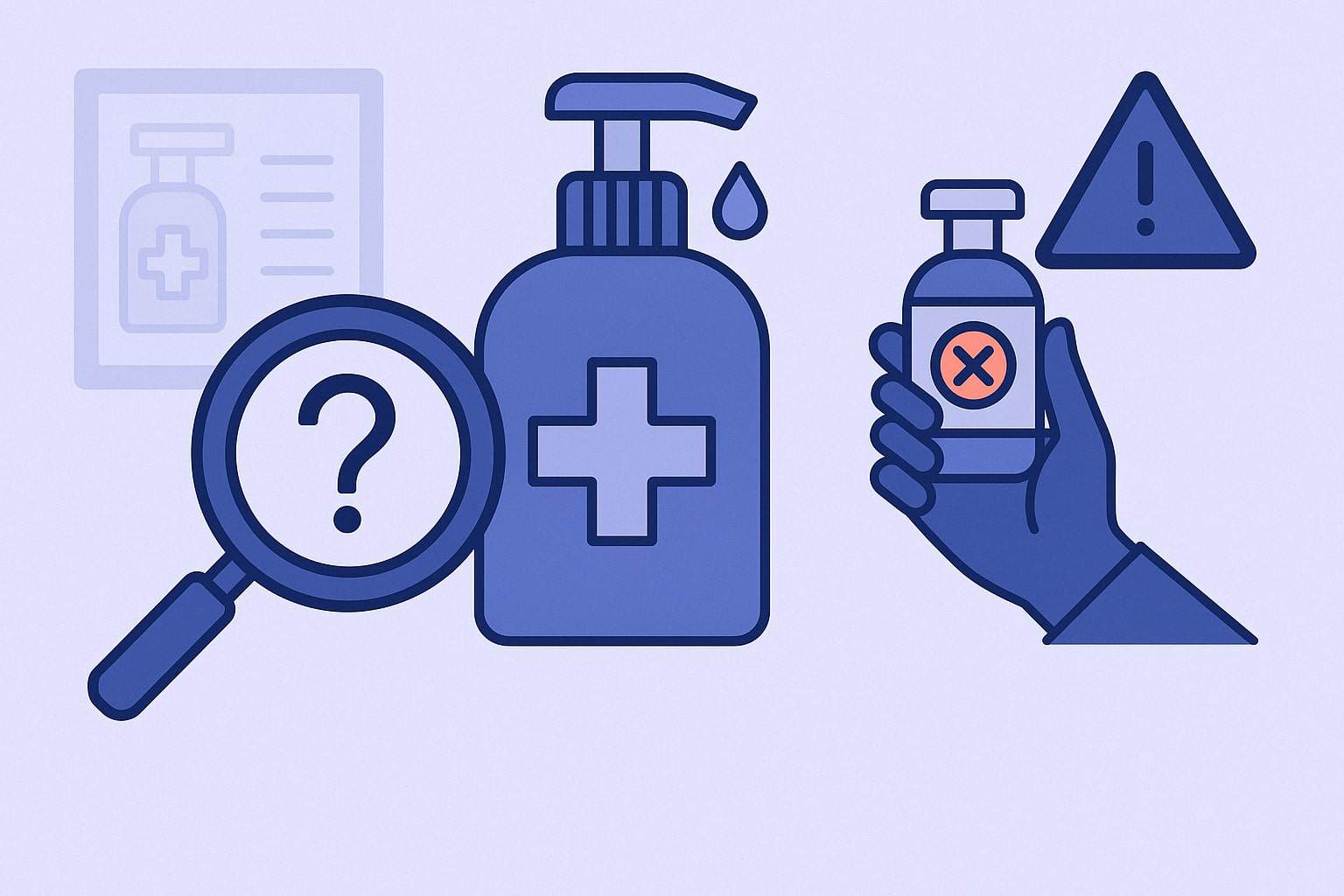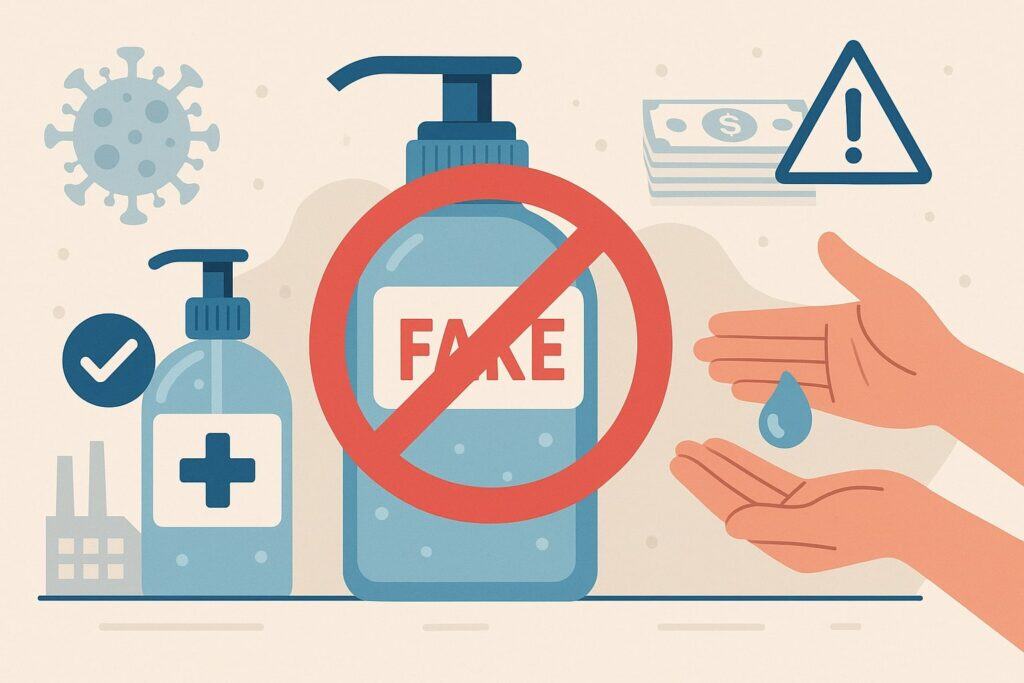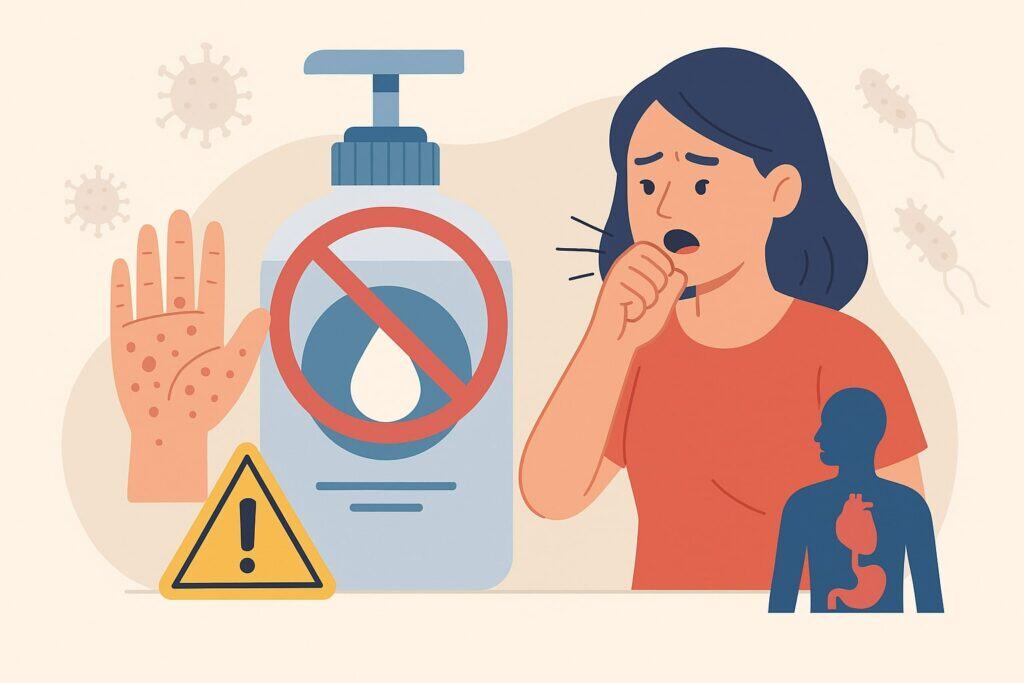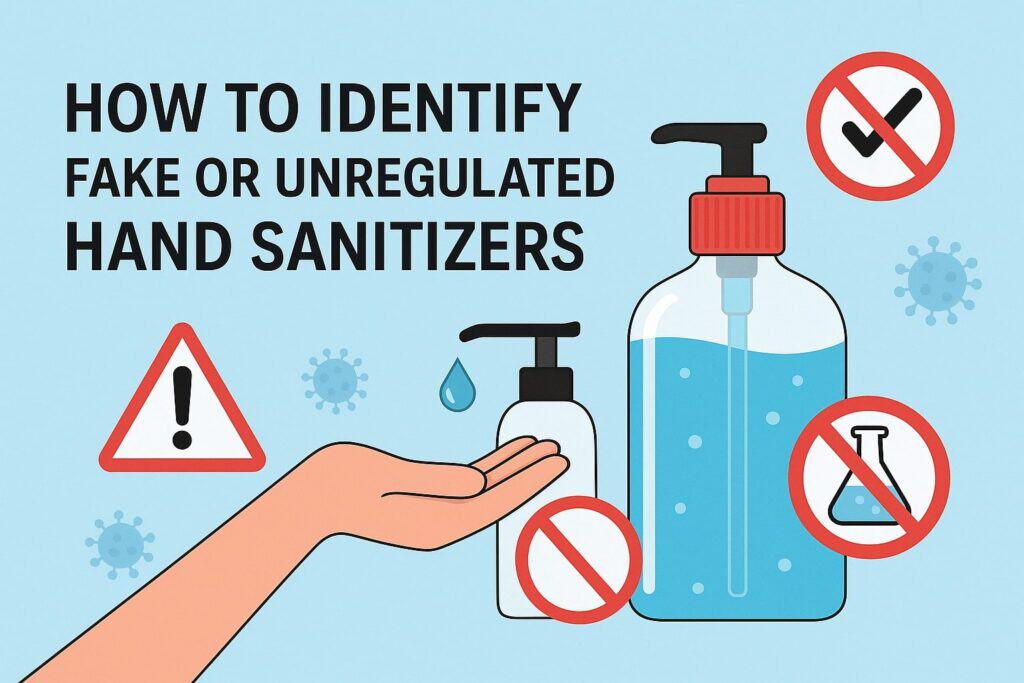
By myhandsanitizershop September 30, 2025
Hand sanitizers have become a household essential, especially in the wake of global health crises such as COVID-19. While they are designed to protect us from harmful pathogens, not all products on the market meet safety and quality standards.
The surge in demand for hand sanitizers has unfortunately opened the door for counterfeit, fake, and unregulated products that can do more harm than good. Recognizing these products is critical not just for personal safety but also for public health.
In this comprehensive guide, we will walk you through the essential signs of identifying fake or unregulated hand sanitizers, explore the dangers associated with them, and provide tips on ensuring you’re using only safe and effective products.
By the end, you’ll have an in-depth understanding of how to protect yourself and your family from fraudulent products masquerading as protective solutions.
Why Fake and Unregulated Hand Sanitizers Exist

The sudden rise in consumer demand for hand sanitizers during pandemics, flu seasons, and other health emergencies creates a perfect storm for opportunistic businesses and counterfeiters.
To maximize profits, some manufacturers cut corners, skipping regulatory approval or using substandard ingredients. Fake or unregulated products often enter the market through online platforms, pop-up vendors, and even local stores that may not fully vet their suppliers.
The existence of these products is tied to economic incentives. Producing genuine, effective, and safe hand sanitizer requires compliance with strict health regulations, access to pharmaceutical-grade ethanol or isopropyl alcohol, and proper labeling standards.
Counterfeit manufacturers sidestep these costs by using industrial alcohols, heavily diluting solutions, or even substituting harmful chemicals like methanol.
Moreover, during crises, regulatory bodies are often overwhelmed, and counterfeiters exploit these loopholes. In many cases, consumers may not realize they’re purchasing unsafe products because packaging and branding mimic legitimate companies.
Understanding the motivations behind these fake products helps us appreciate why vigilance is essential in spotting them.
Health Risks of Using Fake or Unregulated Sanitizers

The dangers of using fake or unregulated hand sanitizers extend far beyond inefficiency. While one might assume that the “worst case” is a product that simply doesn’t kill germs, the reality is far more concerning.
- Toxic Ingredients: Many counterfeit products contain methanol, a chemical that is toxic when absorbed through the skin and potentially fatal if ingested.
Methanol exposure can cause nausea, headaches, blurred vision, seizures, and in severe cases, permanent blindness or death. Unlike ethanol or isopropyl alcohol, methanol is not safe for topical or internal use. - Ineffective Protection: Hand sanitizers must contain at least 60% ethanol or isopropyl alcohol to be effective against pathogens. Fake products often fall below this threshold, leaving users with a false sense of security while failing to neutralize harmful bacteria and viruses.
- Skin Damage: Substandard formulations often contain harsh chemicals or improper pH balances, leading to skin irritation, burns, rashes, or long-term damage to the skin barrier. For individuals with sensitive skin, children, or those with conditions like eczema, the risks are amplified.
- Public Health Consequences: When large groups of people unknowingly use ineffective or harmful products, the risk of infection spread increases dramatically. In the case of COVID-19, this has life-and-death consequences, as communities relying on sanitizers for protection may still transmit the virus at high rates.
- Long-Term Exposure Risks: Repeated exposure to toxins in unregulated products can lead to chronic health issues, particularly when used multiple times daily over weeks or months. This makes identifying and avoiding fake products not just an immediate safety measure but a long-term health necessity.
How to Identify Fake or Unregulated Hand Sanitizers

Spotting counterfeit sanitizers is not always easy, as packaging can be deceptively professional. However, with careful inspection, you can avoid unsafe products.
- Check for Regulatory Approvals: Legitimate sanitizers in the U.S. must be registered with the Food and Drug Administration (FDA). The packaging should include an NDC (National Drug Code) number, manufacturer information, and a proper drug facts label. If these are missing or appear suspiciously vague, it’s a red flag.
- Look for Alcohol Content: The label should clearly state the alcohol content, typically between 60–95%. Anything outside this range is ineffective or potentially harmful. Be wary of products labeled as “alcohol-free sanitizers,” as these do not meet CDC guidelines for effectiveness against viruses.
- Test the Texture and Smell: Fake sanitizers often feel sticky, greasy, or watery, unlike the fast-drying gel or liquid of genuine products. A strong chemical or unusual odor may also signal contamination with toxic substances.
- Inspect Packaging: Poor-quality printing, spelling errors, or generic packaging are often signs of counterfeit goods. Trusted brands usually maintain consistent, professional packaging with batch numbers and expiration dates.
- Research the Manufacturer: If you’re unfamiliar with the brand, do a quick online search. Legitimate companies will have a traceable presence, including websites, reviews, and FDA listings. Counterfeit companies may lack this digital footprint or mimic existing brands with slight spelling variations.
- Be Cautious with Online Marketplaces: Third-party sellers on platforms like Amazon, eBay, or independent websites may sell fake sanitizers. Always verify the seller, check reviews, and when possible, purchase directly from pharmacies or official retailers.
Regulatory Guidelines and Consumer Protection
Regulatory agencies play a crucial role in protecting consumers from fake sanitizers. In the U.S., the FDA oversees the manufacturing and sale of hand sanitizers, ensuring compliance with quality and safety standards.
These regulations require manufacturers to use pharmaceutical-grade ethanol or isopropyl alcohol, maintain proper labeling, and undergo routine inspections. During crises, the FDA often releases updated guidelines to accommodate increased demand while still ensuring safety.
For instance, temporary guidance during COVID-19 allowed certain non-traditional manufacturers (like distilleries) to produce sanitizers, provided they adhered to strict formulations and labeling requirements.
Consumers must familiarize themselves with these guidelines to make informed choices. By knowing what constitutes a legitimate product, you’re better equipped to avoid counterfeits.
Additionally, organizations like the World Health Organization (WHO) provide recommended formulations for hand sanitizers, which can be used as a reference point.
Consumer protection agencies and watchdog organizations also regularly publish lists of recalled or banned sanitizers. Checking these resources periodically can help you stay ahead of emerging risks.
Safer Alternatives and Best Practices
While identifying and avoiding fake sanitizers is critical, you should also know what safe alternatives and practices to adopt.
- Soap and Water: Washing hands with soap and water remains the gold standard for removing dirt, bacteria, and viruses. Unlike sanitizers, it is not subject to counterfeit risks, making it the most reliable option when available.
- Trusted Brands: Stick with established, reputable brands with a history of compliance. Large pharmaceutical companies and health-focused manufacturers are less likely to produce counterfeit or harmful products.
- DIY Sanitizer with Caution: While it’s possible to make sanitizers at home using WHO-recommended recipes, this should only be done with proper ingredients and measurements. Errors in formulation can lead to ineffective or unsafe results.
- Limit Overuse: Even with safe sanitizers, excessive use can damage the skin. Balancing sanitizer use with regular handwashing and moisturizing helps maintain skin health.
- Educate Others: Raising awareness within your family and community about the risks of fake sanitizers ensures broader protection. Share tips on identifying legitimate products and encourage buying from verified sources.
Frequently Asked Questions (FAQs)
Q1. Why is methanol so dangerous in hand sanitizers?
Answer: Methanol, also known as wood alcohol, is a highly toxic substance that has no place in products intended for human use. Unlike ethanol or isopropyl alcohol, methanol can be absorbed through the skin, inhaled, or ingested, leading to severe poisoning.
When methanol enters the bloodstream, the body metabolizes it into formaldehyde and formic acid—both of which are toxic to the nervous system, liver, and kidneys.
In mild cases, exposure can cause dizziness, nausea, and headaches. In severe cases, methanol poisoning results in blindness, seizures, coma, and even death. What makes methanol particularly dangerous is that it can take hours before symptoms appear, during which significant internal damage may already be occurring.
This delayed onset often prevents people from seeking immediate medical care. For these reasons, regulatory agencies like the FDA and WHO strictly prohibit methanol in sanitizers.
Q2. Are alcohol-free hand sanitizers effective?
Answer: Alcohol-free sanitizers often use alternative antimicrobial agents like benzalkonium chloride. While these may offer some antibacterial effects, they are generally less effective against viruses such as influenza or COVID-19 compared to ethanol or isopropyl alcohol.
The CDC and WHO consistently recommend alcohol-based sanitizers containing at least 60% alcohol as the standard for effectiveness.
Furthermore, alcohol-free sanitizers can be exploited by counterfeiters who market them as “gentle” or “child-friendly” while providing little to no real protection.
These products may provide a false sense of security, leading users to unknowingly increase their risk of infection. For maximum safety, alcohol-free sanitizers should not replace alcohol-based ones, especially during viral outbreaks or in healthcare settings.
Q3. How can I verify if a sanitizer is FDA-approved?
Answer: The FDA maintains a searchable online database of registered drug products, including hand sanitizers. By checking the brand name, NDC number, or manufacturer, consumers can quickly verify whether a product is legitimate. FDA approval also ensures the sanitizer adheres to formulation and labeling standards.
In addition to the FDA database, many regulatory bodies worldwide provide similar resources. Consumers should also consult the FDA’s regularly updated list of recalled or banned hand sanitizers.
If a product is not listed, has vague manufacturer information, or seems to appear suddenly in the market during times of crisis, it is best avoided.
Q4. Is making DIY hand sanitizer safe?
Answer: DIY hand sanitizer recipes often circulate during shortages, but their safety depends heavily on accurate formulations. The WHO provides a reliable recipe using ethanol or isopropyl alcohol, hydrogen peroxide, glycerol, and sterile water.
However, precise measurements and proper mixing techniques are critical. If the alcohol concentration falls below 60%, the product becomes ineffective. If too concentrated, it may cause skin damage.
Another challenge with DIY sanitizers is contamination risk during preparation. Without sterile environments, products may harbor bacteria or fungi, undermining their purpose.
Therefore, while DIY sanitizers can be a temporary solution during shortages, they should not replace commercially regulated products whenever those are available.
Q5. What should I do if I’ve used a fake or unsafe sanitizer?
Answer: If you suspect you’ve used a fake sanitizer, stop using it immediately and check for symptoms like nausea, headaches, blurred vision, or skin irritation. In the case of methanol exposure, seek medical attention immediately, as early intervention significantly improves outcomes.
You should also report the product to the FDA or your local regulatory authority. This not only protects you but also helps prevent others from being harmed.
Retain the packaging and, if possible, provide batch numbers or purchase details when filing a report. Finally, spread awareness among friends, family, and colleagues to ensure they avoid similar risks.
Conclusion
Fake and unregulated hand sanitizers represent a hidden but serious threat to public health. While they often masquerade as legitimate products, the risks of toxic ingredients, ineffective protection, and long-term harm are too great to ignore.
By learning how to identify these products, understanding regulatory guidelines, and sticking to trusted sources, you can protect yourself and your community.
The key takeaway is simple: vigilance saves lives. Always check labels, verify manufacturers, and when in doubt, rely on soap and water. By making informed choices, you not only safeguard your health but also contribute to the fight against counterfeit products that endanger us all.